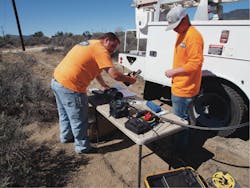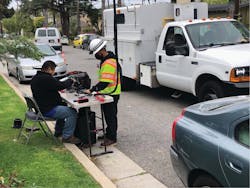Recruiting and Training Today’s Fiber Optic Workforce
When giving talks about fiber optics, I often joke that when I started in fiber optics over 40 years ago, there were Ph.Ds. from Bell Labs doing the installations. Today, it’s everybody: electricians, IT and security techs, cable guys, and lots of people who learned in school or changed careers to become fiber techs.
Today's fiber tech probably started in some role in communications and learned fiber optics because their work required it. They may have taken a class to learn the basic knowledge and skills, then honed their skills with OJT, or on-the-job training. Or maybe they just learned on their own via some online classes.
In the early days, fiber techs were generally called “splicers”. In the telcos, that was the first unique role for techs installing fiber optics. Cable plant construction, including installing cable, was not significantly different from copper cable. Splicing was something new, requiring a new set of skills, but something practically any field tech could learn in a few days. Testing, however, was strictly for the Bell Labs types, with big expensive gear (the early OTDRs) that required a highly knowledgeable tech to operate it and interpret test results.
We’re now a couple of generations of workers into fiber optics. Practically everybody from the beginning has retired, including many of those who learned the trade working for traditional telephone companies. Today’s fiber tech probably started in some role in communications and learned fiber optics because their work required it. They may have taken a class to learn the basic knowledge and skills, then honed their skills with OJT, or on-the-job training. Or maybe they just learned on their own via some online classes.
When the Fiber Optic Association (FOA) started in 1995 by a dozen founders from the industry, education and government, its aim was to create a fiber optic technician certification that would be appropriate across all applications of fiber optics. We spent over a year developing the KSAs (Knowledge, Skills and Abilities) that define the qualities of a competent worker.
Just what does that mean, you ask? Fiber optic KSAs includes cable installation and preparation, splicing, termination, and testing. (Source: https://www.foa.org/KSAs.html)
- The “K” or knowledge part of the KSAs includes fiber optic jargon, the language of fiber optics, how fiber itself works, how communications systems use fiber, then the more practical knowledge of components and installation processes like splicing, terminating, and testing.
- The “S” or skills of the KSAs involve installing cable and preparing it for splicing and termination. Splicing and termination bring tools into the equation and students must learn how to use all of them. Likewise, testing skills involve learning to use equipment that can be simple like visual fault locators or complex like OTDRs.
- The “A” or abilities of the KSAs could also be aptitude, including the ability to use tools properly. Vision, for example, is an important ability for a fiber tech’s work. Into this category, some add attitude, having the qualities to become a reliable, productive worker.
In a nutshell, the KSAs are straight- forward. Being a fiber tech is not rocket science. But it does require someone with a reasonable educational background and the desire to learn manual skills. What’s more, fiber techs get to use some pretty cool tools too!
Two years ago, the problem was competing with colleges. Young people were being told to get a college degree, and easy loans made it possible. Today, there is a growing movement to steer students into the trades where they can "earn while they learn.
The Recruiting Challenge
Let’s face it, today most top fiber techs have their choice of jobs because the demand greatly exceeds supply, at least here in the US. In fact, the US telecommunications industry employs a total of 672,000 workers, with average annual wages of $77,500. It’s forecasted that 5G rollout and other technologies could create 850,000 more “new direct broadband and 5G jobs” through 2025.
To meet the openings being created by the expansion of fiber broadband networks and 5G RANs (radio access networks), we need to get more creative. Online advertising is one way to find workers and many of these have categories for fiber optics. But online sites can sometimes be arbitrary and miss good candidates while providing lots of unqualified ones.
Our advice to many contractors is to develop your own workforce. It’s imperative to start recruiting younger workers, especially as the senior ones are retiring from the workforce. Two years ago, the problem was competing with colleges. Young people were being told to get a college degree, and easy loans made it possible. Today, there is a growing movement to steer students into the trades where they can "earn while they learn".
Since the next round of federal broadband funding will be managed at the state level, there is an incentive to get workforce development started early. Contractors who already see the labor shortage can start pushing their state to get training programs going now.
Another source of fiber techs is one that few consider. Only about 3% of the fiber optic workforce are women, in spite of the fact that experience shows they are well suited to the work. This opportunity should not be overlooked. Last year, FOA interviewed a group of female fiber techs in Alaska. These professionals loved the work. They also request OJT to improve their skills.
Jim Hayes is the Fiber Optic Expert Columnist for ISE Magazine
He is a lifelong techie who has been involved in the fiber optic industry since the late 1970s. He founded one of the world's first fiber optic test equipment companies, FOTEC, which was acquired by Fluke in 2000, and he was a co-founder of the Fiber Optic Association, the international professional society of fiber optics, in 1995. Jim currently serves as President of the FOA. He is the author of nine books on fiber optics and cabling and writes for several magazines. Jim and his wife, Karen, who is the GM of the FOA, have traveled the world for the FOA helping set up schools to train the workers who design, build, and operate today's communications networks.
For more information, email [email protected] or visit www.jimhayes.com. To learn more about the Fiber Optic Association, visit www.thefoa.org.
About the Author
Jim Hayes
Fiber Optic Expert
Jim Hayes is the Fiber Optic Expert columnist for ISE Magazine. He is a lifelong techie who has been involved in the fiber optic industry since the late 1970s. He founded one of the world's first fiber optic test equipment companies, FOTEC, which was acquired by Fluke in 2000, and he was a co-founder of the Fiber Optic Association (FOA), the international professional society of fiber optics, in 1995.
Jim is a writer and trainer and the President of FOA. He is the author of nine books on fiber optics and cabling and writes for several magazines.
Jim and his wife, Karen, who is the GM of the FOA, have traveled the world for the FOA helping set up schools to train the workers who design, build, and operate today's communications networks. The FOA offers nearly 1,000 pages of online technical materials, over 100 videos, and two dozen free self-study courses online.
For more information, email [email protected] or visit www.jimhayes.com.
To learn more about The Fiber Optic Association, visit www.thefoa.org. Follow them on Facebook: FiberOpticAssociation, LinkedIn: company/the-fiber-optic-association-inc-foa, and YouTube: user/thefoainc.


